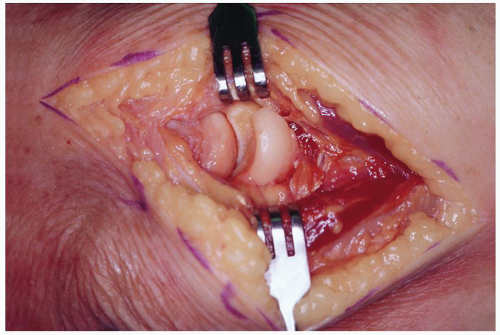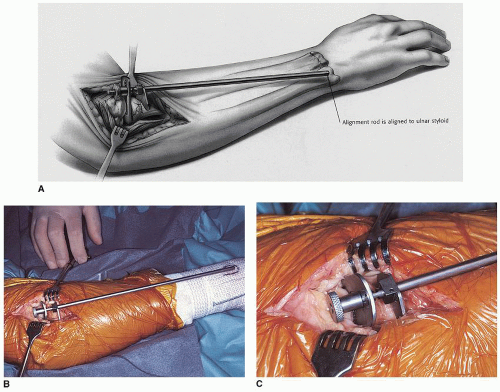Radial Head Prosthesis
Bernard F. Morrey
INTRODUCTION
INDICATIONS/CONTRAINDICATIONS
Contraindications
Patients in whom there are no associated injuries and in whom the fracture cannot be fixed should be treated by simple excision.
CONSIDERATIONS OF IMPLANT SELECTION
Today, there are an increasing number of prosthetic replacement options (Fig. 6-1). These options vary primarily according to the philosophy of implant fixation. All implants today employ a metal articulation against the native cartilage of the capitellum. Within the various options, there are in some instances additional opportunities for an “articulating” or a fixed type of articulation interface (Table 6-1). There are no definitive data in the literature that direct one toward selecting rigid or intentional loose fixation. If rigid fixation is desirable, there are two options: the use of cement or biologic fixation. The technique for these two possibilities differs only in the sense primarily with regard to the preparation of the medullary canal.
SURGICAL TECHNIQUE, GENERIC
The exposure is the same as for open reduction and internal fixation above. If the joint is tight, it may be necessary to release a portion of the lateral ulnar collateral ligament (LUCL) from its humeral origin (Fig. 6-2).
Step 1: After the fracture fragments have been removed, the neck is “freshened” by a clean resection.
Note: I prefer to use an alignment guide so that this resection is perpendicular to the long axis of the forearm rotation (Fig. 6-3).
INTRAMEDULLARY PREPARATION
This preparation depends upon the nature of the implant. For loose-fitting implants, awl and rasp are introduced down the canal (Fig. 6-4).
These are sized in a way that the implant will fit as designed specifically to allow rotation of the stem and slight axial translation within the stem.
For Press-Fit applications, a very specific tight fit is required of the preparation.
The largest rasp allowed by the anatomy is employed.
Note: Avoid an excessively large rasp as this will result in the implant “hanging up,” which could cause “stuffing” of the joint or can cause a split or additional fracture of the proximal radius. If cement is used, the technique of rasping is less critical.
TABLE 6-1 Implant Design Characteristics | |||||||||
|---|---|---|---|---|---|---|---|---|---|
|
 FIGURE 6-2 If the lateral ligament complex is intact, it may be necessary to release a portion of its humeral attachment to provide adequate exposure. |
 FIGURE 6-3 The alignment device is inserted in the joint. The distal portion is placed over the ulnar styloid (A,B), and the proximal portion rests against the capitellum (C). |
SIZING
The sizing of the radial head is absolutely critical for prosthetic replacement. Previous strategies to replicate the full diameter of the fractured radial head overestimated the needed size (Fig. 6-5). The key is the size of the articular surface, not the circumference of the radial head. If in doubt, we always select one diameter of the radial head that is smaller than what the anatomy would seem to indicate neck length. The neck length can be estimated based on the amount of resected neck.
If the resection approaches the tuberosity of the radius, we employ a long-stemmed implant as the additional distance from capitellar to resection places excessive stress on the radial stem (Fig. 6-6).











